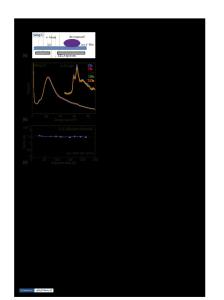In situ transmission electron microscope study of interface sliding and migration in an ultrafine lamellar structure
- PDF / 402,772 Bytes
- 7 Pages / 585 x 783 pts Page_size
- 48 Downloads / 427 Views
In situ transmission electron microscope study of interface sliding and migration in an ultrafine lamellar structure L.M. Hsiunga) and J. Zhou Lawrence Livermore National Laboratory, Chemistry and Materials Science Directorate, Livermore, California 94551
T.G. Nieh The University of Tennessee, Department of Materials Science and Engineering, Knoxville, Tennessee 37996 (Received 13 December 2005; accepted 12 July 2006)
The instability of interfaces in an ultrafine TiAl-(␥)/Ti3Al-(␣2) lamellar structure by straining at room temperature has been investigated using in situ straining techniques performed in a transmission electron microscope. The purpose of this study was to obtain experimental evidence to support the creep mechanisms based upon the interface sliding in association with a cooperative movement of interfacial dislocations, which was proposed previously to rationalize a nearly linear creep behavior of ultrafine lamellar TiAl alloys. The results reveal that the sliding and migration of lamellar interfaces can take place simultaneously as a result of the cooperative movement of interfacial dislocations, which can lead to an adverse effect in the performance of ultrafine lamellar TiAl alloy. I. INTRODUCTION
Two-phase [TiAl (␥-L10) and Ti3Al (␣2-DO19)] lamellar TiAl alloys have recently attracted a great deal of attention because of their low density ( ⳱ 3.9 g/cc), high specific strength, adequate oxidation resistance, and good combination of ambient temperature and elevated temperature mechanical properties, which are of interest for aerospace and transportation applications such as high-temperature components in turbine and combustion engines. Through alloy design and microstructural optimization, significant progress has been made to improve room temperature ductility/toughness and hightemperature creep resistance of the alloys.1–5 Previous research has revealed that the alloys fabricated by hot extrusion of gas-atomized TiAl powder at 1400 °C can form ultrafine lamellar microstructures in association with interlocking colony boundaries through a shearassisted eutectoid transformation induced by hotextrusion process.6 The hot-extruded lamellar alloys provide a better combination of room temperature and hightemperature mechanical properties than those of lamellar
a)
Address all correspondence to this author. e-mail: [email protected] This paper was selected as the Outstanding Meeting Paper for the 2005 MRS Spring Meeting Symposium BB Proceedings, Vol. 880E. DOI: 10.1557/JMR.2006.0311 J. Mater. Res., Vol. 21, No. 10, Oct 2006
http://journals.cambridge.org
Downloaded: 19 Mar 2015
alloys fabricated by conventional ingot metallurgy. Accordingly, there is great interest in further refining lamellar spacing of the alloys to submicron or nanometer length-scales to develop TiAl nanophase composites for engineering applications. However, because the operation of lattice dislocations within refined ␥ and ␣2 lamellae is largely constrained, interfacial dislocations are considered to become the major strain carr
Data Loading...











